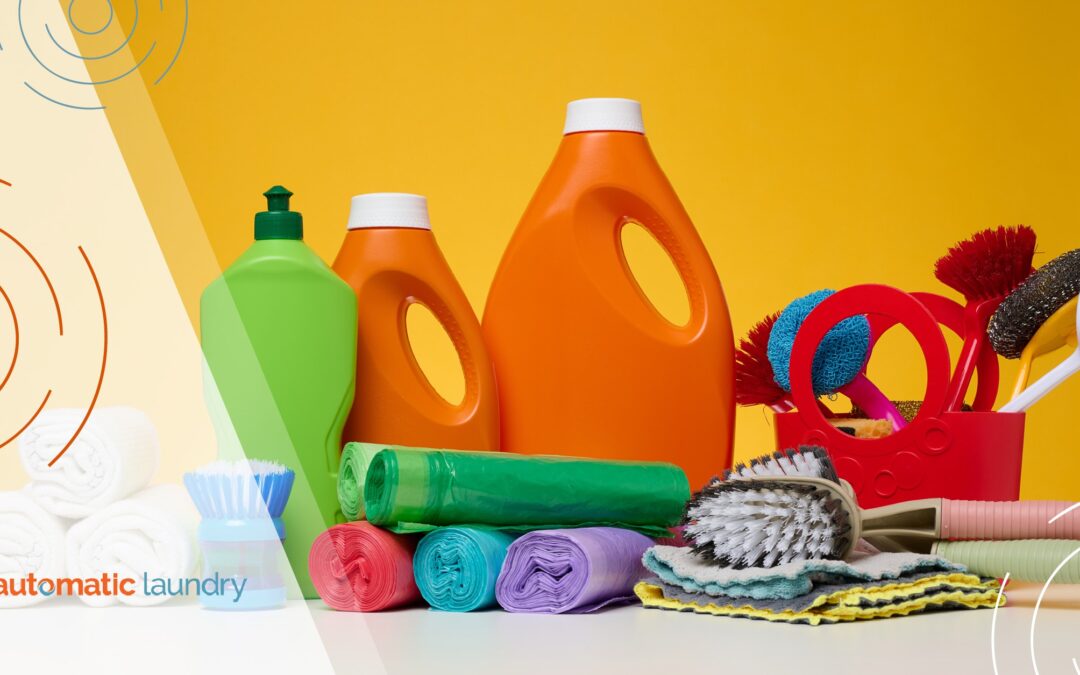Prioritizing hygiene in shared or high-traffic laundry spaces helps freshen laundry and keeps your facility safe and welcoming. Some laundry facilities serve dozens – if not hundreds – of people each day. With that many people using the same machines and touching the same surfaces, germs, dirt, and allergens can quickly build up, increasing health risks and diminishing the user experience.
Freshening laundry in a shared facility is about more than clean clothes. It’s about creating a safe, hygienic space that protects everyone from harmful bacteria and viruses. Organizations can foster trust, encourage repeat use, and provide a positive experience for every user when they maintain high standards of cleanliness and safety.
This article explores the difference between sanitizing and cleaning, and how to keep your laundry facilities fresh and welcoming.
Cleaning vs. sanitizing: what’s the difference to freshen laundry?
Understanding the difference between cleaning and sanitizing is essential for anyone looking to truly freshen laundry and maintain a safe, healthy environment in shared laundry facilities. While these terms are often used interchangeably, they serve distinct and equally important purposes, especially in high-traffic laundry areas.
Cleaning is the first step in the process. It involves removing visible dirt, dust, lint, and debris from surfaces and machines using detergents or soaps. Cleaning physically eliminates many germs by washing them away. However, it doesn’t necessarily kill them. Wiping down washers, dryers, folding tables, and other high-touch surfaces keep shared laundry machines fresh and clean. Regular cleaning also helps freshen laundry by preventing the buildup of residues and odors that can transfer to fabrics.
Sanitizing goes a step further. It uses chemical agents to reduce the number of microorganisms – bacteria, viruses, and fungi – on surfaces considered safe by public health standards. This is especially important in shared laundry spaces, where many people handle the same equipment throughout the day. Sanitizing is what truly helps protect users from illness and ensures your facility meets hygiene and safety guidelines.

Why both steps are critical to freshen laundry in high-touch laundry areas
High-touch points such as washer and dryer doors, payment terminals, folding tables, and door handles are constant hotspots for germ transmission in shared laundry facilities. To truly freshen laundry and protect everyone who uses the facility, organizations must address visible and invisible threats. Cleaning these surfaces removes grime, lint, and residues that can harbor germs, while sanitizing goes further by reducing invisible pathogens to safe levels.
Shared laundry rooms experience frequent turnover, with many users handling the same equipment throughout the day. This increases the risk of cross-contamination and the spread of illness, making a two-step approach of cleaning followed by sanitizing critical. Relying on just one step leaves gaps in protection and can compromise the health and safety of your community.
The CDC and OSHA recommend prioritizing the hygiene of high-touch surfaces in public and shared facilities to reduce the risk of disease transmission. Consistently applying cleaning and sanitizing routines helps organizations freshen laundry and keep their laundry rooms compliant, safe, and welcoming for every user.
Practical tips to freshen laundry and keep shared laundry rooms hygienic
Keeping your laundry facility clean, safe, and welcoming is about more than just appearance. It’s about protecting everyone who uses your space. Here’s how to freshen laundry and maintain a hygienic environment, step by step.
The first critical step is to establish a routine cleaning schedule for all high-touch surfaces. At least twice daily is recommended. Use cleaning agents suitable for shared laundry rooms to remove lint, dust, and grime. This foundational step freshens laundry by preventing residue transfer and prepares the surfaces for effective sanitizing.
Other steps include:
- Effective sanitizing. After cleaning, apply an EPA-registered sanitizer to all high-touch areas, including door handles, control panels, and payment kiosks. Always follow product instructions for contact time to ensure maximum germ reduction. Sanitizing after cleaning is crucial to reduce bacteria and viruses to safe levels, as recommended by public health authorities.
- Laundry machine hygiene. Encourage users to wipe down machine handles and buttons before and after use. Providing disinfectant wipes or hand sanitizer stations near machines makes this easy and supports a community-wide effort to freshen laundry and reduce cross-contamination.
- Facility best practices. Post clear signage to remind users about hand hygiene and cleaning protocols. Ensure adequate ventilation to reduce airborne contaminants and train staff on the difference between cleaning and sanitizing, including the proper sequence. Consider using laundry-safe sanitizing cycles or additives to further freshen laundry and reduce pathogens on fabrics.
- Compliance and safety. Always use products approved for laundry environments and check for EPA registration numbers on sanitizers and disinfectants. Maintain detailed records of cleaning and sanitizing schedules to demonstrate compliance and accountability – a key component of any safe, well-managed facility.

A fresh approach to laundry facility care
Innovative laundry care combines thorough cleaning with targeted sanitizing every day. This two-step process is the most effective way to freshen laundry, safeguard user health, and keep your shared laundry spaces safe and welcoming.
Maintaining these high standards helps organizations meet regulatory compliance and build trust and satisfaction among users. Need help transforming your shared laundry room into a clean and sanitary space? Schedule a consultation with our experts today.


